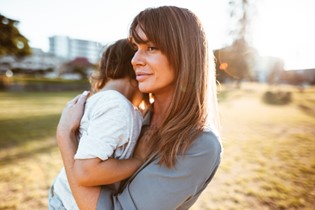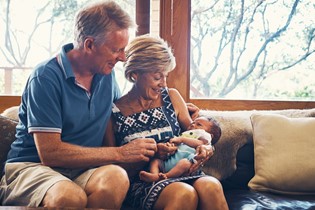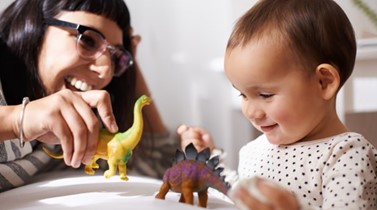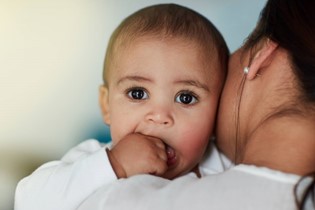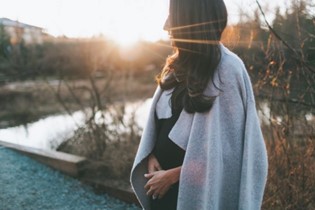Tress stress: why hair changes during and post pregnancy

Unexpected hair changes during pregnancy and after the baby's birth is a fact of motherhood. But that doesn't stop it from being annoying and frightening, so what is going on?
Why is that some women blossom during pregnancy? Their skin glows, their eyes sparkle, and their hair has a new lustre. Others, however, don't have it so good. Hair grows in unwanted places, skin breaks out, and lank locks become an everyday curse.
"It's hormones, mainly," says Dr Teresa Cattin, a former GP who now specialises in appearance medicine. "and each woman is different. While some women 'blossom' in pregnancy, others don't have quite the same experience."
A change in how much hair you actually have - whether on your head or other parts of the body - is just one of the changes women notice when they become pregnant. "Because of the high sustained oestrogen levels, it's actually quite rare to lose hair during pregnancy," says Dr Cattin. "But it's often a different story once you have had the baby or stop breastfeeding."
Trichologist Nigel Russell has made a career out of dealing with problems of the hair and scalp. "Your hair has three cycles: a growing stage, a resting stage and a falling-out stage," he explains. "During pregnancy, the cycle is disrupted so the hair will grow and enter the resting stage, but will not continue into the falling-out stage. The result is an accumulation of hair, making it feel thicker, more healthy and shiny.
"After the baby's birth, the cycle kicks back into action. There is usually a lag period of about three to five months (which can be delayed by breastfeeding). Then suddenly, all the hair that should have fallen out in the nine-month period comes out in one go.
If you are unaware of the potential causes, any hair loss can be traumatic, says Nigel. "If the mother is healthy, the cycle should settle into its normal routine and grow normally. But if she's low in iron, stressed, or not eating properly, the hair could struggle to retain its former glory."
Most women experience hair loss only after childbirth; the causes for hair loss during pregnancy can be quite different. "If a woman is experiencing significant hair loss or poor condition during pregnancy, it can be an indicator for something more serious - in particular, iron deficiency," warns Dr Cattin.
"Why am I so hairy?"
Hair loss is one thing; unexpected hair growth - especially on the face, under the chin, the stomach, chest, and other areas where it's unwanted - is another. "Some women experience an increase of body hair during pregnancy which recedes over time, but with each succeeding pregnancy, it may increase," says Nigel.
"Hair growth during pregnancy is so individual," agrees beauty therapist Leanne Dore, from Auckland's Beauty Connection. "Some women get hairy, some don't. But your options of how to deal with unwanted hair when you're pregnant are restricted."
Laser therapies and IPL aren't recommended for pregnant women, nor are depilatory creams. "We know chemicals can get into the body because of medical patches," Leanne says. "So we don't advise creams."
Shaving and waxing are better options, but "as you get more pregnant, you often can't get to your legs," Leanne explains. "We have lots of pregnant women coming in for waxing a few weeks before they're due, not only because they can't comfortably remove the hair themselves, but also because they know they're not going to have the time once the baby is born."
Colour my world
Colouring your hair while pregnant is one of those issues that fall into the same camp as alcohol. On one side are those who say you should avoid it altogether; on the other are those who maintain it's fine as long as it's well-controlled.
Nigel, who trained as a hairdresser and has developed a brand of hair products called Holistic Hair, has this view: "The rule of thumb is to not to dye your hair in the first trimester. I would caution against such things as scalp bleach, high lift-tinting, or full-head bleach highlights during the whole term, as these are longer processed treatments requiring chemicals to be left on the hair for long periods of time."
Top colourist Jennifer Morgan, of Morgan & Morgan Hair and Makeup, often sees pregnant clients in her busy Auckland salon. "If anyone is worried, I suggest foils or highlights," she says. "What you want to avoid is contact with the scalp, and both of these processes can be managed so that doesn't happen.
"But even if you do decide not to keep up your colour while you're pregnant, it's important to continue to get it cut and conditioned," she adds. "This will stand you in much better stead once the baby's born and you really don't have a lot of time to spend on styling it. It's also something nice you can do for yourself."

AS FEATURED IN ISSUE 3 OF OHbaby! MAGAZINE. CHECK OUT OTHER ARTICLES IN THIS ISSUE BELOW


